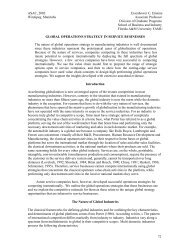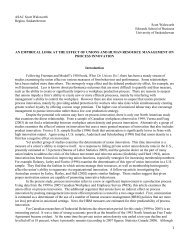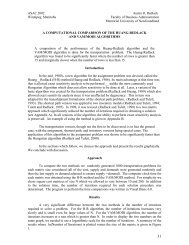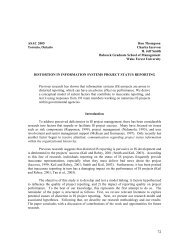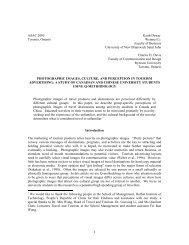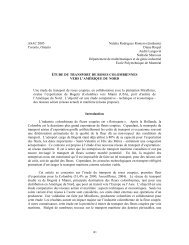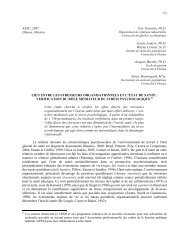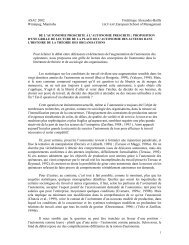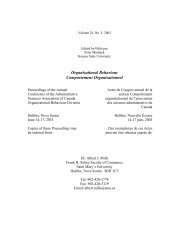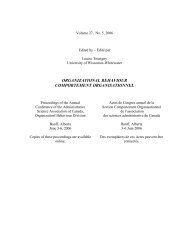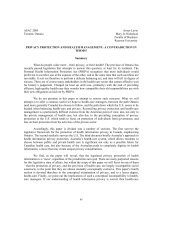that process issues as well as task achievement were given attention. Finally, diversity needed to bevalued in the increasingly heterogeneous organizational and customer world. Each of the changesrepresents a shift in the thinking and behaviour and all of the changes challenged the historical anddominant power structures of both organizations.Table 1 below highlights the characteristics that contribute to the success of the particularchange initiatives attempted in the two case study organisations as well as the characteristics whichdominated the organizations at the time of the research. The middle column captures some of thecommon themes alluded to in the literature which underpin the change initiatives while the thirdcolumn notes some of the contrasting characteristics that were encouraged, valued and rewarded atTechnica and ComCo.Table 1. The Gendered Nature of Organizational ChangeChangestrategyQualityTeamsDiversityCharacteristics of changesEncourages participation & facilitatesinclusion, shares power & information,energises & excites others about work &changes, quality of work life.Collaboration, co-operation,interdependence, concerned about welfare ofothers, not solely motivated by self-interest.Concern about the welfare of others,supportive, receptive, empathetic.Orientation toward power as a transforming& liberating force to be used for publicpurposes rather than for personal ambitionand power over others.FEMININECHARACTERISTICSExisting characteristicsTask focus, quantity focus,achievement-oriented (sales),competition & conflict, awin/lose approach to conflictresolution.Independent, competitive,individual recognition &advancement, self-reliant,Individual recognition &advancement (of behavioursthat fit the status quo),hierarchical structure,forcefulness, status-conscious.MASCULINECHARACTERISTICSAn analysis of the characteristics in the middle column suggests an overlap with femininecharacteristics described previously whereas the characteristics in the third column are congruentwith frequently described masculine characteristics (Fondas, 1997; Marshall, 1984). Hence, wehave labelled the characteristics in the middle column, those associated with the new cultures or thedesired characteristics underlying the change initiatives as ‘feminine’ and the characteristicsassociated with the existing organizational cultures as ‘masculine.’Considering the underlying characteristics of the change initiatives as feminine attributesmight help us understand why the changes were resisted so strongly and therefore failed. Byresisting these changes, the dominant masculine culture continued to be perpetuated whichpromoted and encouraged individualism, competition, task focus and a patriarchal and narrowdefinition of competence and achievement. We suggest that labelling the characteristics of theexisting dominant cultures of ComCo and Technica ‘masculine’ and the new cultures that thechange initiatives necessitated ‘feminine’, offers a gendered lens for exploring culture and change.Such an approach contributes to our understanding of why there was such resistance to the changeinitiatives in both organizations.<strong>ASAC</strong>-<strong>IFSAM</strong> <strong>2000</strong> Proceedings 8
As Morgan (1997) notes, the links between the masculine stereotype and the values thatdominate many ideas about the nature of organizations are striking. Organizations are oftenencouraged to be rational, analytic, strategic, decision-oriented, tough, aggressive, As noted earlier,ideas about masculinity and femininity are embedded in organizational arrangements anddifferentially valued (Fondas, 1997). We do not want to suggest that there was a consciouscategorization of the changes as feminine and therefore imply that the resistance was overt andexplicitly aimed at squashing the feminization of the workplace. People in both companies, at alllevels of the hierarchy, had devised strategies for subverting, ignoring or undermining the changeinitiatives. Feminine characteristics were implicitly embedded in the change initiatives,characteristics that are devalued by society. The resistance served to maintain the status quo andvalue ascribed to masculine characteristics.DiscussionAs long as we continue to treat organizations as gender neutral then we are ignoring andsustaining the patriarchal foundation upon which modern organizations are based. One way tochallenge these premises is to continue to point to the masculinist bias apparent in mostorganizations. What is needed is call into question not what has been socially constructed asfeminine but why these characteristics are ascribed less value and status.Woodward (1996) extended Hofstede’s (1988) national cultural dimension of masculineand feminine to organizations. Masculine, according to this conceptualization, bestows importanceon financial rewards, recognition and challenge whereas the feminine pole values the importance ofrelationships, co-operation, and security of employment. The meanings of the labels of masculinityand femininity have been contentious which have led to interesting modifications. Robbins et al.(1998), an influential writer of management education texts, has relabelled masculinity andfemininity to ‘quantity’ and ‘quality’. In a further adaptation Adler (1998) relabelled Hofstede’sdimensions as ‘career success’ and ‘quality of life.’This re-framing of the masculinity and femininity serves two obvious purposes: It furtherrefines the meanings of the concepts but also highlights the discomfort felt when using concepts ofmasculinity and in particular, femininity. Feminist theorists have underscored the differential valueascribed to feminine characteristics. “There is nothing the matter with difference; the problem isthat one of the two categories … is devalued” (Martin, 1994:8). As evident from the currentresearch findings, this devaluation has significant implications. Masculinity and femininity areassociated with differential status in society that is also apparent in organizational settings.Stereotypical feminine characteristics such as co-operation, empathy, an emphasis on relationshipsand connection are not valued, beyond the rhetorical, in companies such as Technica and ComCobecause of cultures and practices which reinforce competition, individual sales prowess and ‘gettingan edge’ over competitors. So while there may be a desired shift toward incorporating femininecharacteristics there is also a competing resistance that works to maintain the masculine status quo.It is not helpful to elevate the status of one set of characteristics (e.g. feminine) over theother. However, by invoking the terms masculine and feminine and overtly describing theresistance to the feminization of cultures and change initiatives we are highlighting an alternativelens for considering why organizations are struggling to implement critical changes necessary totheir continued success. Furthermore, we are contributing to the growing literature offering agendered perspective to organisational theorizing (e.g. Fletcher, 1994; Smircich, 1985).We acknowledge that restricting our thinking to a dichotomous, oppositional, binarystructure, as Scott (1988) points out, creates an either/or choice. We are not suggesting ‘feminine’<strong>ASAC</strong>-<strong>IFSAM</strong> <strong>2000</strong> Proceedings 9



